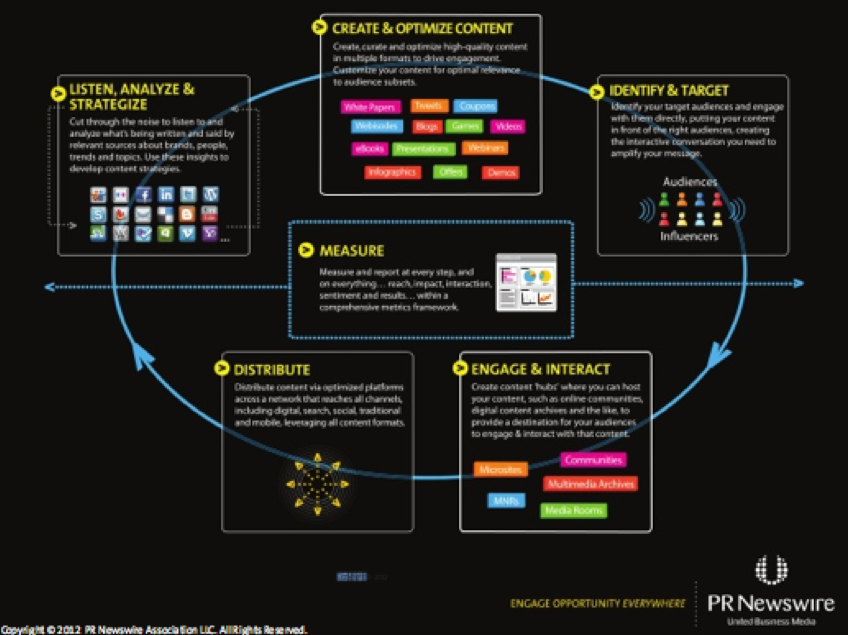Last week, Online Marketing Summit came to San Diego, and much of the Mindgruve team headed out to check out some of the sessions over the conference’s three-day stint. I went on the first morning to sit in on “Driving Qualified Audiences Into the Funnel Using Rich Media and Distribution Networks,” led by PRNewswire’s VP of Social Media, Sarah Skerik. The three-hour session had enough information to span several blog posts, but read on for some key takeaways and thoughts for a pretty solid summation.
- 2013’s Content Marketing Trend of the Moment
Two-way, multichannel communication between brands and consumers is increasingly prevalent and isn’t going anywhere for a very, very long time. When brands are connected with their customers, they’re engaged with their customers as well. In order to create strong, lasting relationships and cultivate high engagement rates, brands must provide value to their fan base. The easiest way? High-quality content. In consistently pushing out quality social posts, blog updates, etc., the brand gains permission to engage through a fair value exchange, says Skerik.
Skerik shared a great quote from Chris Brogan, President and CEO at Human Business Works: “Content marketing is weaponized storytelling.” I sort of tie that with the quintessential Spiderman quote, “with great power comes great responsibility.” Content marketers are equipped with arguably more resources than any other professional in the industry: every word in the English (or any) language at our disposal. We can choose to harness our resources effectively, creating AK-47 content that is clever, concise, and ignites engagement and buzz; or we can be lax and create water balloon content, which may be fluffy and fun, but at the end of the day, has no lasting effect whatsoever.
Skerik put great emphasis on the art of agile marketing, naming it as an essential for audience reach and the framework of content marketing. She then shared a great infographic (below; thanks to her for pushing via @SarahSkerik on Twitter) that outlined the full-circle process needed for connective content to generate strong leads and customer relationships.

- Leveraging Multimedia for PR Wins
I disagree with those who say the press release is dead, but there’s no question it’s needed to evolve and will have to keep doing so to maintain traction. PRNewswire assessed a number of releases sent through their service and discovered that press releases with multimedia content gained much more attention than those without. While in today’s digital age, that in and of itself is a no-brainer, I was actually surprised to see how much of a difference it can make:
- Press release with text and image: 1.8x better response
- Press release with text and video: 4.3x better response
- Press release with text, image, and video: 7.4x better response
- Press release with text, image, video, and downloadable files: 9.7x better response

More thanks to @SarahSherik for providing this infographic.
- When it Comes to Content, Keep it Real
When developing content for anything – PR, websites, social media, etc. – keep it R.E.A.L.: Relevant, Engaging, Actionable, and Leading, recommends Skerik. Beyond that handy little acronym, it’s also important to ensure that your content does, in fact, stay true to your brand and your audience.
Transparency is, in my opinion, a non-negotiable in brand communication, especially when it comes to PR. Can you “spin” a story to make it compelling and target it to specific audiences? Of course – that’s how you pitch (and how journalists write). Can you (or at least, should you) hide critical information? No way. Not only does that defy the cardinal rule of authenticity, it can come back to bite you in a big way. Looking back on a few recent PR crises in which cover-ups were attempted – Sandusky/Penn State and Lance Armstrong come to mind – when the truth was uncovered, things didn’t exactly improve, did they? No brand is perfect, and things happen – but people will move on a lot faster and have lasting respect if you maintain transparency the whole way through.
While Skerik linked these up with press releases in particular, I think they can be applied to any digital content:
- No anchor text links OR
- Too many anchor text links: Depending on the content type and length, a “good” amount can vary. However, if you’re seeing more hyperlinks than regular text… may be time to cut back.
- Linking to “throwaway” words: Since anchor links can give a big boost to SEO rankings, don’t self-sabotage with poor selection. For example, take a look at the following sentence: “For more tips on SEO, check out our website.” In this case, “SEO” would be a much better choice than “website.”
- Long headlines: “Make titles the perfect tweet,” recommends Skerik. While 110-130 characters at most is ideal for the whole headline, keep in mind that search engines only index the first 65 – insert keywords accordingly.
- Jargon: Chances are, you’re not writing for a medical journal or scholarly website -your vocabulary should follow suit. This in no way means you should “dumb down” your content – just make it speak to your audience in a natural way. They’ll appreciate it.
And that, in a slimmed down version, is “Driving Qualified Audiences Into the Funnel Using Rich Media and Distribution Networks” at OMS.